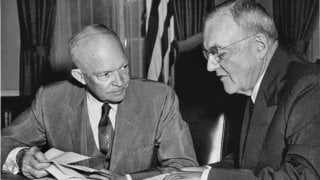How Eisenhower Reshaped the Joint Chiefs and U.S. Military Strategy
When Dwight D. Eisenhower became president, he aimed to overhaul the Pentagon and balance America’s defense spending with economic sustainability, an approach he called the “Great Equation.” To execute his vision, Eisenhower revamped the Joint Chiefs of Staff, appointing new leaders he believed would back his strategic shift toward nuclear deterrence and reduce reliance on conventional forces.
Ridgeway and Carney arrived next, and were summoned, along with Radford and Twining, to the White House for a group meeting with Eisenhower. The five-star president explained what he wanted from them. He desired them to elevate their perspectives above their service’s interests. He felt that he had done this while commanding the alliance forces in Europe during the war and when he had formed the NATO supreme command, and he wanted them to do it now. He wanted them to consider the economic strength as a component of national security. As such he tasked them to create a new military strategy that would place greater emphasis on strategic weapons and deemphasized conventional forces as a means of reducing the costs associated with the national defense. He also held up their nominations until they delivered. The resulting product, the “New Look” military strategy emerged shortly thereafter.
Eisenhower was delighted with the document and used it to justify making significant cuts to the Army and Marine Corps, and, to a lesser degree, the Navy while “plussing-up” the Air Force. Not surprisingly, the heads of the Army and Navy quickly rebelled. Both Ridgeway and Carney pushed back on the assumptions underlying the “New Look” in their public congressional testimony. Eisenhower reacted strongly, “By God, this has got to stop,” he told a staff member, “These fellows like Carney and Ridgway don’t yet realize that they… have a boss.” Both men were dismissed after only two years of service in their respective roles. Ridgeway was replaced by General Maxwell Taylor, Carney by a very junior Rear Admiral Arleigh Burke, who had stood nearly 100 numbers down the seniority list of Navy admirals when he was selected. Both men were extensively interviewed by administration officials to establish that they would, in fact, support Eisenhower’s policies.
Civilian Control of the Military
Eisenhower did change the strategic direction of the nation and the composition of the military services. He shifted from the Truman administration’s short-term strategic focus on “The Year of Maximum Danger” to George Kennan’s “long-haul” containment strategy that ultimately won the Cold War thirty years after he had left office. He also subtly changed the force structure of the military to support his new strategy, cutting nearly 500,000 men from his 1,5000,000-man Army to pay for expanding the Air Force’s bomber fleet while simultaneously creating an entirely new ICBM force from scratch. He also drove through a modernization of the Navy, sacrificing 100 ships from the nearly 1,000 vessel fleet to pay for new nuclear power plants, a new class of “supercarriers” and nuclear-tipped missiles carried in an entirely new class of submarines. To the extent that Eisenhower pursued a “hidden hand” management style, as one scholar famously said, his handling of the Joint Chiefs revealed that it was an iron hand. While Eisenhower, as the last general to sit in the Oval Office, can be seen as a special case, his administration both serves as a case study in modern strategic formulation as well as absolute civilian control over the military.
Editor's Note: Much of this document is drawn from primary sources in the Eisenhower Presidential Library in Abilene, KS, the Charles E. Wilson Papers at Anderson University in Anderson, IN, the National Archives II complex at College Park, MD and the memoirs of Arthur Radford, Matthew Ridgeway, Robert Carney, as well as Arleigh Burke’s oral history and Phillip Meilinger’s biography of Hoyt Vandenberg. The insights regarding the importance Eisenhower placed on forming an entirely new Joint Chiefs is drawn largely from Wilson’s private and professional correspondence with Eisenhower during the transition period following the election but prior to inauguration day.
About the Author
Dr. Jerry Hendrix, PhD, is a retired Navy captain, and a senior fellow with the Sagamore Institute, located in Indianapolis, IN. Dr. Hendrix is the author of the 2009 Theodore Roosevelt’s Naval Diplomacy and 2020’s To Provide and Maintain a Navy. He is the recipient of the United States Navy League’s Alfred Thayer Mahan Award for Literary Achievement.
Image Credit: Creative Commons.


